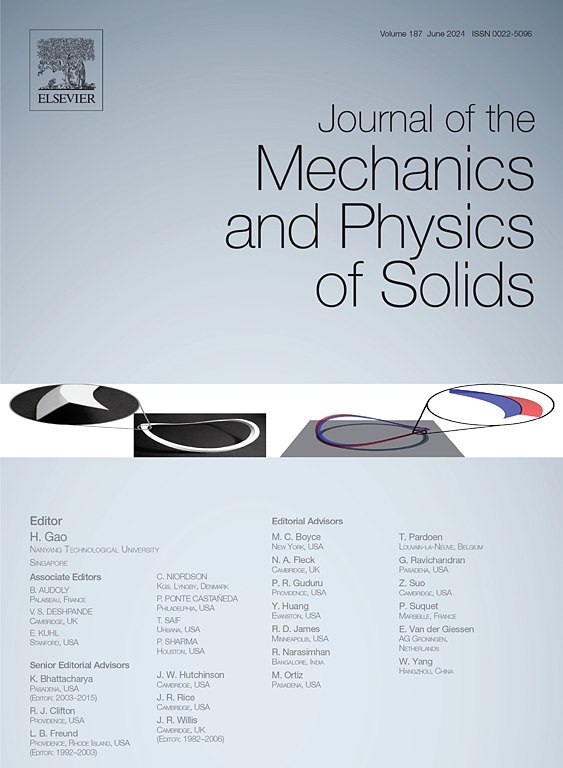Tunable entanglement and strength with engineered staple-like particles: Experiments and discrete element models
IF 5
2区 工程技术
Q2 MATERIALS SCIENCE, MULTIDISCIPLINARY
引用次数: 0
Abstract
Entangled matter displays unusual and attractive properties and mechanisms: tensile strength, capabilities for assembly and disassembly, damage tolerance. While some of the attributes and mechanisms share some traits with traditional granular materials, fewer studies have focused on entanglement and strength and there are large gaps in our understanding of the mechanics of these materials. In this report we focus on the tensile properties and mechanics of bundles made of staple-like particles, and particularly on the effect of adjusting the angle between the legs and the crown in individual staples. Our experiments, combined with discrete element models, show competing mechanisms between entanglement strength and geometric engagement between particles, giving rise to an optimum crown-leg angle that maximizes strength. We also show that tensile forces are transmitted by a small fraction of the staples, which is organized in only 1–3 force chains. The formation and breakage of these chains is highly dynamic: as force chains break, they are replaced by fresh ones which were previously mechanically invisible. Entangled matter offers interesting perspectives in terms of materials design which can lead to unusual combination of properties: simultaneous strength and toughness, controlled assembly and disassembly, re-conformability, recyclability.
可调谐的纠缠和强度与工程钉状粒子:实验和离散元素模型
纠缠物质表现出不同寻常的、吸引人的特性和机制:抗拉强度、装配和拆卸能力、损伤容忍度。虽然一些属性和机制与传统颗粒材料有一些共同的特征,但很少有研究集中在缠结和强度上,我们对这些材料的力学理解存在很大差距。在本报告中,我们着重于由钉状颗粒制成的束的拉伸性能和力学,特别是在调整单个钉之间的腿和冠之间的角度的影响。我们的实验,结合离散单元模型,显示了粒子之间的纠缠强度和几何接合之间的竞争机制,从而产生了最大强度的最佳冠腿角。我们还表明,拉力由一小部分订书钉传递,这些订书钉组织在只有1-3个力链中。这些链的形成和断裂是高度动态的:当力链断裂时,它们被以前在机械上看不见的新链所取代。纠缠物质在材料设计方面提供了有趣的视角,它可以导致不同寻常的特性组合:同时的强度和韧性,控制的组装和拆卸,再整合性,可回收性。
本文章由计算机程序翻译,如有差异,请以英文原文为准。
求助全文
约1分钟内获得全文
求助全文
来源期刊
CiteScore
9.80
自引率
9.40%
发文量
276
审稿时长
52 days
期刊介绍:
The aim of Journal of The Mechanics and Physics of Solids is to publish research of the highest quality and of lasting significance on the mechanics of solids. The scope is broad, from fundamental concepts in mechanics to the analysis of novel phenomena and applications. Solids are interpreted broadly to include both hard and soft materials as well as natural and synthetic structures. The approach can be theoretical, experimental or computational.This research activity sits within engineering science and the allied areas of applied mathematics, materials science, bio-mechanics, applied physics, and geophysics.
The Journal was founded in 1952 by Rodney Hill, who was its Editor-in-Chief until 1968. The topics of interest to the Journal evolve with developments in the subject but its basic ethos remains the same: to publish research of the highest quality relating to the mechanics of solids. Thus, emphasis is placed on the development of fundamental concepts of mechanics and novel applications of these concepts based on theoretical, experimental or computational approaches, drawing upon the various branches of engineering science and the allied areas within applied mathematics, materials science, structural engineering, applied physics, and geophysics.
The main purpose of the Journal is to foster scientific understanding of the processes of deformation and mechanical failure of all solid materials, both technological and natural, and the connections between these processes and their underlying physical mechanisms. In this sense, the content of the Journal should reflect the current state of the discipline in analysis, experimental observation, and numerical simulation. In the interest of achieving this goal, authors are encouraged to consider the significance of their contributions for the field of mechanics and the implications of their results, in addition to describing the details of their work.

 求助内容:
求助内容: 应助结果提醒方式:
应助结果提醒方式:


